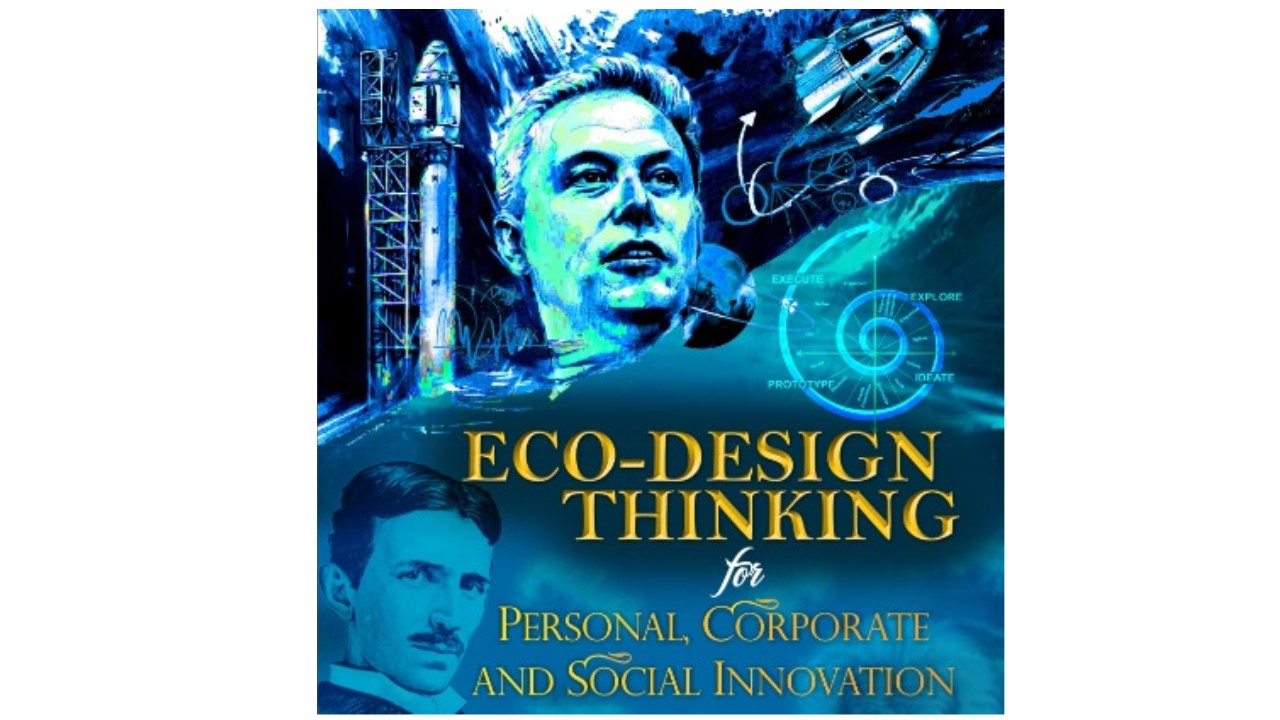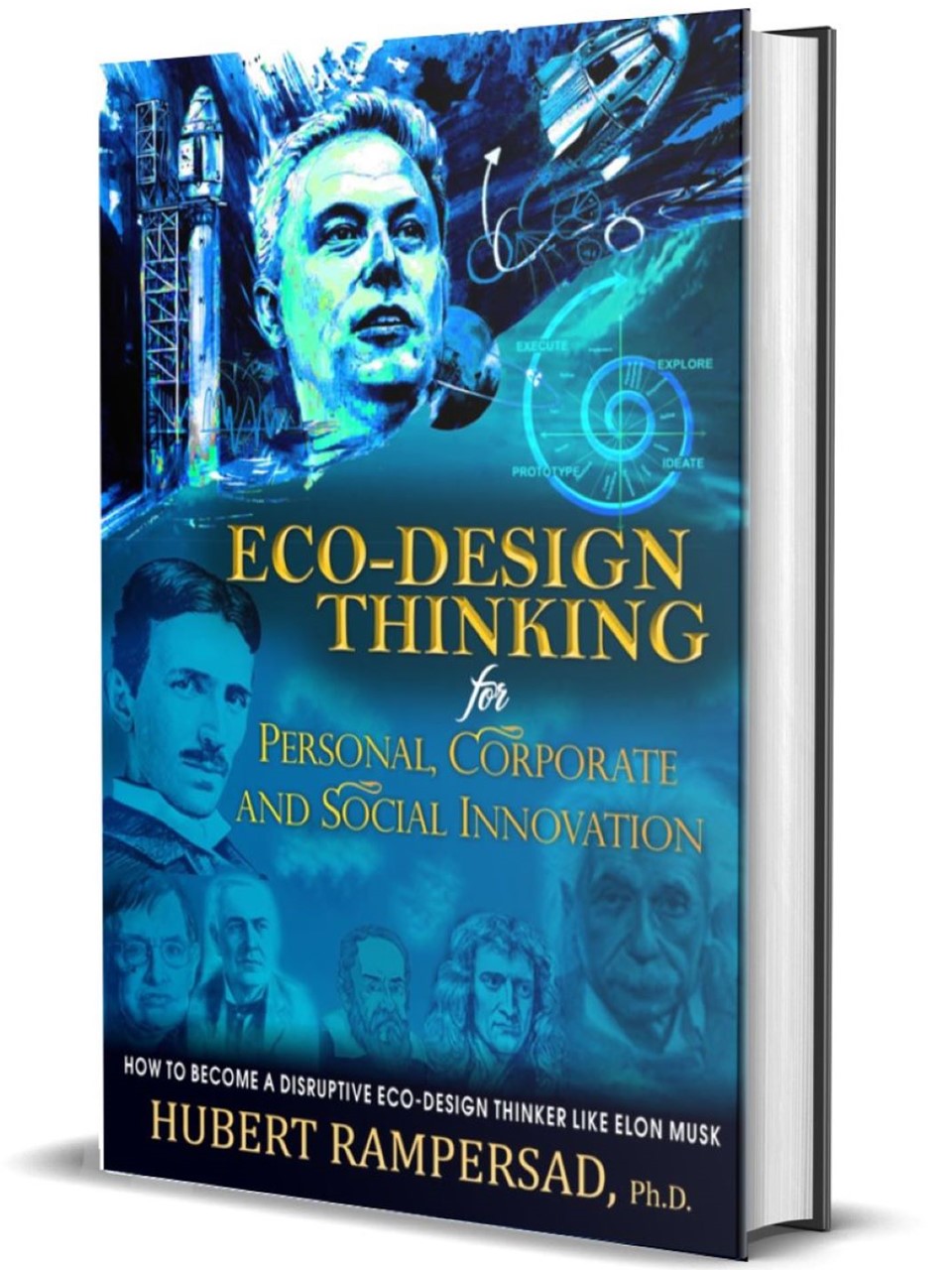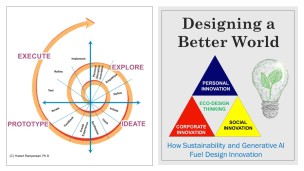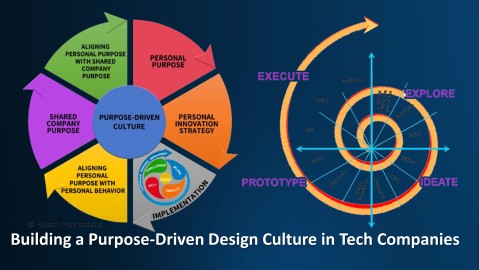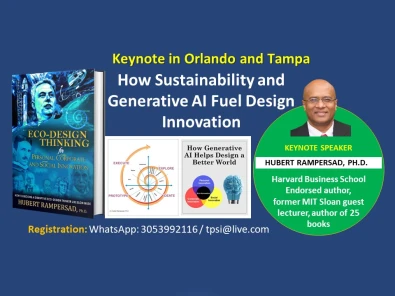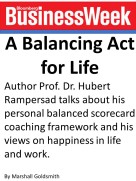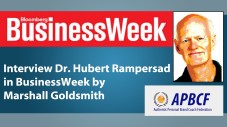Reimagining Design Innovation
Hubert Rampersad, Ph.D.
“AI is reshaping industries, enhancing efficiency & productivity, and pushing the limits of what is possible. As a result, the job market is evolving, and while some jobs will become automated, new opportunities will arise. The future of work will involve humans collaborating with AI to accomplish tasks more efficiently. Therefore, organizations must reskill and upskill their workforce to ensure individuals possess the necessary abilities to thrive in this AI-driven future. To keep up with AI and adapt to unpredictable circumstances, Personal Disruptive Innovation is essential in developing critical thinking skills, future-proofing our careers, and allowing us to thrive in this future”. – Hubert Rampersad.
We have entered an era of dramatic innovation in AI and automation, which will significantly impact the future of jobs and productivity. Research predicts that AI-powered worker productivity could increase by as much as 4x by 2030. Recent research by the Massachusetts Institute of Technology underscores the significant impact of AI on productivity. The study showed that workers using AI, particularly ChatGPT, experienced a remarkable 37% improvement in productivity.
The emergence of generative AI has brought significant changes across various fields, including innovation, revolutionizing manufacturing processes, and developing more intelligent AI agents. It empowers them to think more creatively. However, it also raises important ethical considerations. For instance, generative AI can inherit and perpetuate biases in training data, propagate hate speech and false information, and even generate content that could potentially raise copyright issues. Critics say AI tools can be biased, cause misinformation, and sometimes disturb users with cryptic responses.
Experts at the AI Decoded panel emphasize that the partnership between humans and machines will lead to innovation and progress. Rather than complete automation, the future of work may involve humans collaborating with AI to accomplish tasks more efficiently. The job market will also evolve. While some jobs may be automated, new opportunities will emerge in AI development, data science, and cybersecurity. The World Economic Forum predicts that more than 97 million jobs will be created due to technological advancements, while 85 million jobs will be displaced. This underscores the importance of reskilling, the need to address talent shortages, and be prepared for shifts in the labor market. Organizations need to reskill and upskill their workforce to prepare for AI. This will be critical to prepare the workforce for the new emerging roles. Organizations must invest in training and upskilling programs to ensure individuals have the necessary skills to thrive in this AI-driven future. Eco-design thinking is the best tool for training, reskilling, and upskilling individuals to prepare them for AI so that they can work harmoniously with AI.
On the other hand, the pandemic has taught us valuable lessons, including the need for a better world characterized by empathy, personal integrity, non-racialism, environmental responsibility, efficiency, circularity, a revised role for human resources, good governance, and ethical leadership. This better world should prioritize sustainability in design innovation, HR, leadership, diversity and inclusion, corporate governance, and higher education. The accompanying Figure illustrates this.

A Novel Approach to Design Thinking
The era of design thinking has come to an end. Read my article “The End of Design Thinking: Cultivating a Purpose-Driven Design Culture to Fix the World.” Eco-design thinking goes beyond traditional design thinking. It is based on my latest book, “Eco-Design Thinking for Personal, Corporate, and Social Innovation.” In this excerpt, I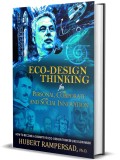 discussed the concept of reimagining design innovation. This book is based on my experience as a senior design innovation coach at ASML, the most important tech company in the world and Europe’s most valuable tech firm, the only tech company in the world with a design-driven culture.
discussed the concept of reimagining design innovation. This book is based on my experience as a senior design innovation coach at ASML, the most important tech company in the world and Europe’s most valuable tech firm, the only tech company in the world with a design-driven culture.
To design a better world, we must adopt new design methods and ways of thinking. As Einstein famously stated, “We cannot solve our problems with the same thinking we used when we created them.” That’s where eco-design thinking emerges, shifting from the traditional fixed mindset to a more dynamic growth mindset. We need to adopt this fresh new mindset to create a better world. My article”How to Design a Better World” is insightful.
The starting point in this inside-out and outside-in eco-design thinking model is self-knowledge. All knowledge, learning, and innovation stem from personal innovation. Without Personal integrity and self-awareness, design thinking lacks empathy and sustainability. Therefore, eco-design thinking requires understanding oneself first and foremost. As Aristotle once said, “Knowing yourself is the beginning of all wisdom,” which is a value Elon Musk, the disruptor, also recognizes.
Personal integrity and self-awareness, design thinking lacks empathy and sustainability. Therefore, eco-design thinking requires understanding oneself first and foremost. As Aristotle once said, “Knowing yourself is the beginning of all wisdom,” which is a value Elon Musk, the disruptor, also recognizes.
My article “Top-10 Causes of Bad Designs” highlights the negative impact of bad designs due to a lack of consideration for sustainability and generative AI. Some well-known examples of such methods include the botched vaccine rollout in America, Citibank’s loss of $500 million due to an unfriendly loan management tool, the $2 trillion F-35 project, Boeing 737 Max airplane, the T-14 Armata Russian Tank, and the Samsung Galaxy Note 7. Please take the time to read my article “Why OceanGate’s Design Approach Sucks.” CEOs who prioritize their personal design choices over critical safety regulations, endangering human lives, can learn a valuable lesson from the tragedy of the Titan. This also applies to individuals like Elon Musk and companies like Boeing. Please look at my article “How could Elon Musk’s $3 billion Mars rocket failure have been avoided?”.
Approach Sucks.” CEOs who prioritize their personal design choices over critical safety regulations, endangering human lives, can learn a valuable lesson from the tragedy of the Titan. This also applies to individuals like Elon Musk and companies like Boeing. Please look at my article “How could Elon Musk’s $3 billion Mars rocket failure have been avoided?”.
Top 10 causes of bad designs:
- INCOMPETENT DESIGNERS: Designers don’t use their right brain and left brain in
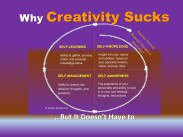 a balanced way, lacking an intuitive, open, empathic, ethical, and growth mindset. Read “Why Creativity Sucks“.
a balanced way, lacking an intuitive, open, empathic, ethical, and growth mindset. Read “Why Creativity Sucks“. - DESIGN PROCESS HAS ENDPOINT: The design process should be a never-ending, non-linear, circular, iterative, incremental, cyclic, and concentric process that never stops.
- NON-HOLISTIC DESIGN APPROACH: The design method should prioritize cultivating a purpose-driven design culture that positively impacts society.
- FOCUS ON KNOWLEDGE RATHER THAN IMAGINATION: The design method should take an inside-out approach to creativity, emphasizing the designer’s imagination.
- DESIGNERS LACK GENUINE EMPATHY AND PERSONAL INTEGRITY: The higher your personal integrity, the better your attentiveness, the better your empathic skills, the better your design. Genuine empathy starts with personal integrity.
- NON-DISRUPTIVE DESIGNERS: The design method should start with designing the designer’s life to become disruptive with a growth-open mindset.
- DOES NOT FACILITATE THE USE OF GENERATIVE AI: Designers lack critical thinking skills to use generative AI tools like Stable Diffusion and ChatGPT to create novel designs.
- BAD DESIGN LEADERS: Design leaders lack the coaching skills to cultivate team learning and enhance team performance.
- DISENGAGED DESIGN TEAMS: To enhance the designer’s engagement, aligning and synchronizing the designer’s ambition with the design team’s ambition is needed.
- COZY DESIGN MEETINGS AND USE OF TOOLS: The design method focuses mainly on a process-driven, analytical thinking, cozy, theatrical design process, and completing related tasks in a particular order using design tools.
The figure below illustrates the top 10 reasons behind these bad designs.

We must adopt a new design method that is better suited for generative AI to design a more sustainable world. Traditional design thinking approaches lack sustainability due to their limited scope and focus on process-driven analytical thinking. In contrast, an authentic and holistic approach would inspire imagination, creativity, and innovation more effectively and sustainably. Cozy meetings are not necessarily required to generate.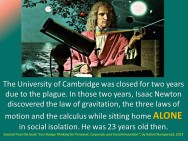 Innovative ideas, as often as the best ideas, come from working alone. Nikola Tesla, for instance, generated a wealth of creative ideas in solitude. At the same time, Stephen Hawking made groundbreaking discoveries from his wheelchair, and Sir Isaac Newton discovered gravity while in social isolation.
Innovative ideas, as often as the best ideas, come from working alone. Nikola Tesla, for instance, generated a wealth of creative ideas in solitude. At the same time, Stephen Hawking made groundbreaking discoveries from his wheelchair, and Sir Isaac Newton discovered gravity while in social isolation.

It’s worth recalling the wise words of Nikola Tesla and Albert Einstein about the benefits of solitude for generating innovative ideas. Tesla once said, “Being alone is when ideas are born. This is the secret of innovation.” Similarly, Einstein advised, “Be a loner. That gives you time to wonder, to search for the truth. Have holy curiosity. Make your life worth living.” These insights are embraced by Elon Musk.
To design a better world sustainably, a new design innovation approach is necessary, one that prioritizes personal, corporate, and social innovation. Traditional innovation methods fall short of sustainability as they lack a holistic and ethical perspective. Real sustainability requires a unified system that benefits humans and nature over time. This is the driving force behind my eco-innovation concept, which emphasizes the link between personal, corporate, and social innovation. Additionally, my book delves into the eco-innovation model, which utilizes eco-design thinking to promote eco-innovation.
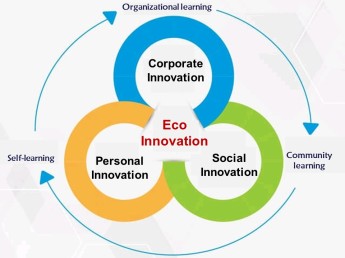
Personal innovation is critical to achieving a sustainable circular economy through eco-design thinking. Without it, corporate and social innovation will only be surface-level. Eco-design thinking involves convergent and divergent thinking and creative, intuitive thinking. Unlike linear analytical thinking, this type of thinking is iterative and cyclic. Redesigning the world for the better requires a shift from a fixed mindset to a growth mindset. Check out the figure below to see the difference between the two ways of thinking.
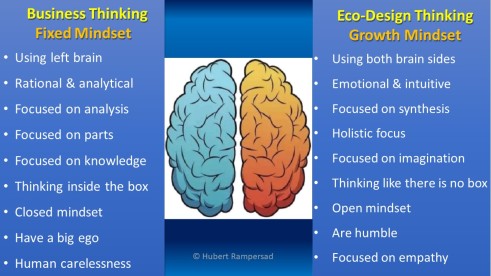
I’m excited to share my new book, which presents an eco-design thinking model for designing innovative products and services that consider all aspects of life. This approach involves an iterative, incremental, cyclic, and concentric process of exploring, ideating, prototyping, and executing. The various stages within this model often form iterative loops and can occur in any order.
 Through each iteration, new insights are uncovered, paving the way for the designer and customer to reach an acceptable level of satisfaction. Eco-design thinking is a continuous circular process that involves testing and refining the design while empathizing with yourself, the user, and the environment. My eco-design thinking model aligns with Elon Musk’s iterative design process, which centers on a cyclic approach of prototyping, evaluating, analyzing, and refining. Rather than investing in an enormous and costly spacecraft to transport humans to Mars, Musk constructed a smaller rocket and continually improved its design.
Through each iteration, new insights are uncovered, paving the way for the designer and customer to reach an acceptable level of satisfaction. Eco-design thinking is a continuous circular process that involves testing and refining the design while empathizing with yourself, the user, and the environment. My eco-design thinking model aligns with Elon Musk’s iterative design process, which centers on a cyclic approach of prototyping, evaluating, analyzing, and refining. Rather than investing in an enormous and costly spacecraft to transport humans to Mars, Musk constructed a smaller rocket and continually improved its design.
 SpaceX employs an iterative design process that involves inspecting the spacecraft, identifying potential defects, repairing them, and advancing the project. Similarly, eco-design thinking is centered on making iterations. By integrating my eco-design thinking and personal disruptive innovation concept, Elon Musk’s iterative design process could be further enhanced to create better, more cost-effective, faster rockets. Personal disruptive innovation is the critical missing element in Elon Musk’s iterative design process. This new book also reveals the secrets of SpaceX’s ability to construct rockets faster and cheaper than its rivals.
SpaceX employs an iterative design process that involves inspecting the spacecraft, identifying potential defects, repairing them, and advancing the project. Similarly, eco-design thinking is centered on making iterations. By integrating my eco-design thinking and personal disruptive innovation concept, Elon Musk’s iterative design process could be further enhanced to create better, more cost-effective, faster rockets. Personal disruptive innovation is the critical missing element in Elon Musk’s iterative design process. This new book also reveals the secrets of SpaceX’s ability to construct rockets faster and cheaper than its rivals.
Personal Disruptive Innovation Framework and Roadmap
Personal disruptive innovation is an innovative approach that unlocks your creative potential by cultivating a strong growth mindset, creating new unique opportunities, disrupting your current target market, and allowing you to make a significant social impact. This model involves five steps to promote authenticity, integrity, and sustainability, as shown in this model: 1. Personal Ambition, 2. Personal Brand, 3. Personal Innovation Strategy, 4. Implementation, and 5. Personal Integrity & Empathy.
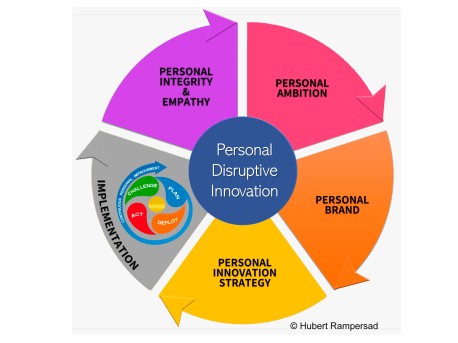
My article “Cultivating Critical Thinking in the Age of AI“describes this model in detail.
By embracing personal disruptive innovation, you can revolutionize your mindset and become a true disruptor. Rather than thinking outside the box, you’ll learn to think like there was no box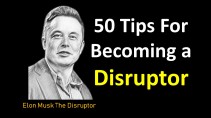 , though there were none. This requires reinventing yourself, tapping into your creative potential, and cultivating emotional intelligence and resilience. Additionally, personal disruptive innovation involves developing a personal branding system based on eco-design thinking, which can be used to effectively tell your story at every stage of the design process. I recommend reading my articles “50 Tips For Becoming a Disruptor“ and “Crafting Your Authentic Personal Brand: A 5-Step Guide”.
, though there were none. This requires reinventing yourself, tapping into your creative potential, and cultivating emotional intelligence and resilience. Additionally, personal disruptive innovation involves developing a personal branding system based on eco-design thinking, which can be used to effectively tell your story at every stage of the design process. I recommend reading my articles “50 Tips For Becoming a Disruptor“ and “Crafting Your Authentic Personal Brand: A 5-Step Guide”.
This personal eco-design branding blueprint aims to enhance your storytelling skills and set you apart from others in the industry. By following its guidelines, you’ll learn what it takes to succeed as an eco-design professional and in life. Eco-design thinking involves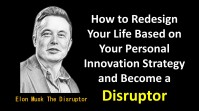 aligning personal and corporate innovation, enhancing personal integrity and empathy, and improving designer engagement within your team. Refer to the accompanying Figure for more details. The included personal eco-design thinking branding blueprint will strengthen your storytelling and distinguish you from the crowd. It shows what an eco-design thinking professional should do to succeed in the design industry and life. Generative AI tool ChatGTP is a helpful tool for improving storytelling.
aligning personal and corporate innovation, enhancing personal integrity and empathy, and improving designer engagement within your team. Refer to the accompanying Figure for more details. The included personal eco-design thinking branding blueprint will strengthen your storytelling and distinguish you from the crowd. It shows what an eco-design thinking professional should do to succeed in the design industry and life. Generative AI tool ChatGTP is a helpful tool for improving storytelling.
To achieve alignment with oneself, I recommend reading my article “Reimagining Leadership.” It’s worth remembering Einstein’s wise words: “When you look at the most prominent figures in history, you’ll notice they were all in sync with their spiritual selves before their physical selves.” To align with your design team, check out my article “How to Boost Employee Engagement and Design Team Performance at SpaceX and Tesla.” “Aligning Personal Innovation with Corporate Innovation” is also Aligning Personal Innovation with Corporate Innovation” is an essential read.
before their physical selves.” To align with your design team, check out my article “How to Boost Employee Engagement and Design Team Performance at SpaceX and Tesla.” “Aligning Personal Innovation with Corporate Innovation” is also Aligning Personal Innovation with Corporate Innovation” is an essential read.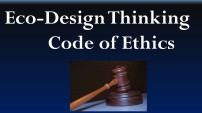
Ethics are crucial in the design thinking industry, as the profession’s reputation depends on the actions of individual designers. I have developed the Eco-Design Thinking Code of Ethics to promote ethical decision-making.
Eco-design thinking involves considering environmental, technological, social, ethical, and cultural factors and taking a people-focused, holistic, and interdisciplinary approach. It’s an excellent fit for the new normal. I can help you establish your own Eco-Design Thinking Lab, enabling your team to unlock their creative potential and solve complex design challenges sustainably. This initiative can impact society by bringing together people and practitioners from diverse backgrounds and perspectives. With the help of an eco-design thinking tool kit, your practitioners can tackle real-world issues sustainably. Read also “Building a Purpose-Driven Design Culture in Tech Companies.”
To gain more knowledge about this subject, you may consider attending his Orlando-Tampa Live Events:
Building a Purpose-Driven Design Culture in Tech Companies
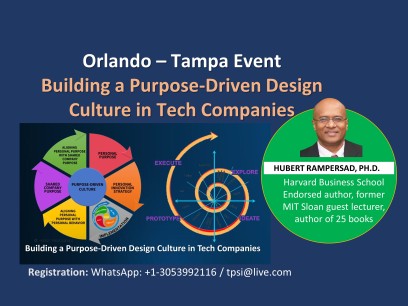
Purpose-Driven and Human-Centered AI
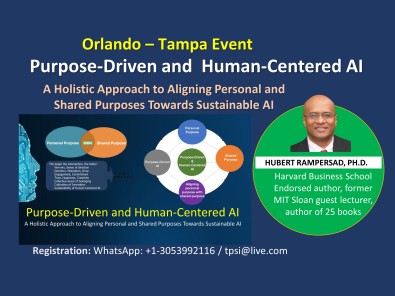
“How Sustainability and Generative AI Fuel Design Innovation.”
You may also want to consider attending his free live webinar:

Hubert Rampersad, Ph.D., founded the Center of Excellence in Human-Centered and Purpose-Driven AI Innovation in Orlando. He is a visionary leader in innovative solutions for genuine sustainability, disruptive design innovation, critical thinking in the age of AI, human-centered and purpose driven AI, and entrepreneurial leadership. He holds a Ph.D. in Innovation Sciences, an MSc in Technology Engineering & Robotics, and a BSc in Mechanical Engineering from leading accredited universities in the Netherlands (Delft University of Technology, Eindhoven University of Technology). He is a well-known futurist, advocating for genuine sustainability on a global scale. With extensive knowledge and expertise, he has authored 25 books on the topics above in many languages and is highly regarded for his insights in these fields. One of his books, “Total Performance Scorecard,” has been published in 20 languages. Dorothy Leonard, an innovation professor at Harvard Business School, wrote the book’s foreword. Rampersad has also previously served as a guest lecturer at MIT Sloan and was featured in BusinessWeek. He was a senior design innovation coach at ASML (the Most Important Tech Company in the World).
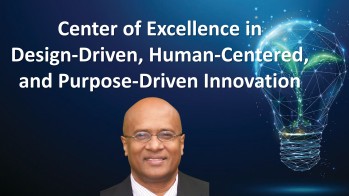
Orlando, Florida | tpsi@live.com | Phone/WhatsApp: +13053992116
